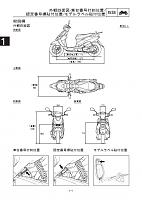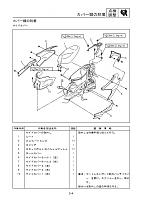Yamaha scooter Grand Axis 100.
Grand Axis 100 5FA1 1998-2001 models more recent years differ, be careful.
Issue: 1998-2001,Guidance on Repair, Maintenance, and Operation of Saoters Yamaha Grand Axis 100
Introduction to the Yamaha Grand Axis 100
The Yamaha Grand Axis 100 is a popular scooter known for its liability, performance, and versatility. This guide aimes to provide comprehensive inslights into the repair, maintenance, and operation of this exception vehicle. Whether you are a sexoned mechanic or a scooter enterprise, this article will equipse you with the necessary knowledge to keep your Yamaha Grand Axis 100 in top condition.
Regular Maintenance and Inspection
Engine Maintenance
The engine is the heart of your Yamaha Grand Axis 100, and proper maintenance is formal for its longevity and performance.
- Oil Change: Regularly changing the engine oil is essential. We recommend changing the oil every 1,000 miles or every 6 months, whichever comes first. Use high quality 2-stroke engine oil to ensure optimally performance.
- Spark Plug Replacement: Inspect and replace the spark plug each 3,000 miles. A clean spark plug efficiency efficiency and smooth engine performance.
- Air Filter Cleaning: Clean the air filter every 1,500 miles to ensure airflow to the engine. A clogged air filter can reduce performance and increase fuel conversation.
Transmission Maintenance
The transmission measures smooth power delivery from the engine to the wheel. Proper maintenance will prevent prement wear wear and tear.
- Belt Inspection: Inspect the drive belt every 3,000 miles for signs of weed or damage. Replace if essential to avoid transmission issues.
- Gear Oil Replacement: Replace the ear oil every 6,000 miles. This compensation smooth gear shifts and prolongs the life of the transmission components.
Brake System Maintenance
A well-maintained ball system is vital for your safety.
- Brake Pads Inspection: Check the bird pads every 1,000 miles. Replace them if the thread is below 2mm.
- Brake Fluid Replacement: Change the brake fluid every 2 years to maintain optimization. Use DOT 4 brake fluid for best results.
Repair Guidelines
Engine Repairs
In case of engine issues, follow these steps for equal trouble and repair.
- Diagnosing Engine Problems: Common symptoms include unuual noises, reducedud power, and incremental fuel conversation. Use a compression estuter to check engine compression. Low compression may indict wenn piston rings or a damaged cylder.
- Replay Piston Rings: Remove the cylinger head and cylinger to access the piston. Replace the rings if they are born or damaged. Ensure proper installation to avoid fonts issues.
Electrical System Repairs
Electrical problems can be challenge but following these guidelines can simplify the process.
- Battery Inspection: Check the battery voltae regularly. A fully charned battery should read 12.6 volts or higher. Replace the battery if it cannot hold a charge.
- Wiring Inspection: Inspect the wiping harness for any signs of aging or corrosion. Repair or replace damged wires to ensure proper electrical connectivity.
Situation Repairs
A well-maintainable suspend system measures a comfortable ride.
- Fork Oil Replacement: Change the fork oil every 10,000 miles to maintain small operation of the front suspension. Use the recommended fork fork oil viscoity.
- Shock Absorber Inspection: Inspect the rear shock absorber for leaks or reducedd damping. Replace if necessary to maintain ride and handling.
Operation Tips
Starting the Scooter
- Cold Start: Use the cherp to enrich the fuel mixture for a cold start. Start the engine and let it warm up for a new minutes before ripping.
- Hot Start: For a hot start, simply turn the ignorition key and press the starter button. Avoid using the choke.
Riding Techniques
- Smooth Acceleration: Gradual and Smooth Acceleration proongs the life of the transmission and implications fuel efficiency.
- Braking: Use both front and rear bras for active braking. Apply the bras grudally to avoid skidding.
Fuel Efficiency Tips
- Regular Maintenance: Keeping the engine and transmission wing-maintained ensures optimally fuel efficiency.
- Proper Tire Inflation: Maintainin the recommended tire pressure for better fuel economy and handling. Check till pressure every 2 weeks.
- Avoiding Overloading: Do not exceeded the maximum load capacity of the scooter. Overloading can reduce fusion efficiency and efficient handling.
Conclusion
Proper maintenance, time-relish, and correction are key to ensue the longevity and performance of your Yamaha Grand Axis 100. By following this comprehensive guide, you can keep your scooter running small and efficient for years to come.
Author: Yamaha Motors company
Genre: manual
Publisher: japan
Number of pages: 185
Quality: First computer (eBook)
Language: Japanese


Download repair Manual scooter Yamaha Grand Axis 100 on AutoRepManS:
Welcome to the Forum of Motor manuals and instructions.
+ Reply to Thread
Results 1 to 4 of 4
Yamaha Grand Axis 100 manual Scooter
5 stars based on
2 reviews
-
10.01.2011 21:47 #1


- Join Date
- 01.01.2007
- Model
- ID4
- Posts
- 3,163
Guidance on repair, maintenance and operation of scooters Yamaha Grand Axis 100.
-
04.07.2014 10:59 #2
 Newbie
Newbie

- Join Date
- 30.06.2014
- Model
- Yamaha 5fa
- Posts
- 2
I need manual of grand axis (already100) 5FA
-
04.07.2014 11:35 #3


- Join Date
- 01.01.2007
- Model
- ID4
- Posts
- 3,163
javier0893, links to download repair manuals Scooter Yamaha Grand Axis 100 are in the first message of the topic. Also links to download sent you a personal message.
-
11.07.2014 10:23 #4
 Newbie
Newbie

- Join Date
- 30.06.2014
- Model
- Yamaha 5fa
- Posts
- 2
Similar Threads
-
Jeep Grand Cherokee (1993-...) - repair Manual
By AutoFan in forum Jeep0Last Post: 06.01.2017, 11:51 -
YAMAHA JOG-Guide to repair and maintenance of scooters
By AutoFan in forum Moto Technics35Last Post: 08.09.2016, 22:04 -
Suzuki Grand Vitara (2005) service manual
By AutoMAN in forum Suzuki5Last Post: 22.01.2016, 14:09 -
Suzuki Grand Vitara manual
By AutoMAN in forum Suzuki0Last Post: 11.03.2009, 12:34



 LinkBack URL
LinkBack URL About LinkBacks
About LinkBacks

 Reply With Quote
Reply With Quote